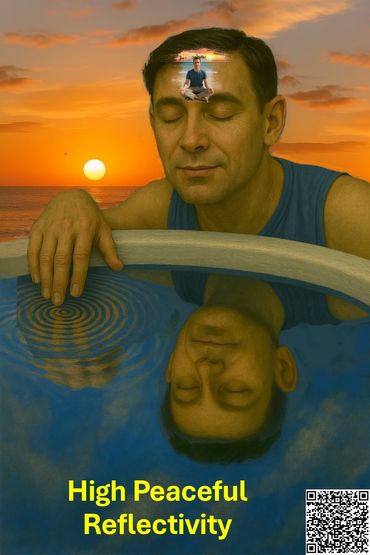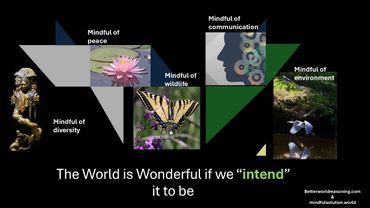Positive Reasoning (Brief) Selections
Mindfulness project 2025 [Scan QR for facts • Tap > to advance]
Why Awareness? Test your Awareness
Mindful Reasoning is.. to Mindful Solutions slide program
mindful Solutions
Mindful Solutions for People and Society

A. For People and Society
- Support physical and emotional health and well-being
- Foster relational communication and collaborative participation
- Ensure meaningful, purposeful employment
- Provide secure and dignified housing
- Promote social equity and inclusion
- Uphold safety and psychological stability
- Design sustainable systems and infrastructure for all
- Guide population approaches through care and long-term thinking
- Restore media integrity grounded in logic, truth, and transparency
- Uphold human rights and justice—respecting biodiversity and cultural diversity
- Encourage democratic teamwork representing all voices, across all communities
- Cultivate healthy awareness, reflection, and reasoning—for self, others, and our interdependent ecosystem
Mindful Solutions for Biodiversity and Earth

B. Earth – Mindful Solutions for Biodiversity and Ecosystem Health
- Circular systems and regenerative practices that minimize waste and renew natural resources
- Clean air and water for all living systems through protection and equitable access
- Pollution reduction driven by innovation, accountability, and compassionate care
- Preservation of biodiversity through sustainable protection of species and ecosystems
- Ecological stewardship that nurtures the beauty, balance, and vitality of natural habitats
- Habitat restoration and rewilding to reconnect disrupted ecosystems and support keystone species
- Environmental justice ensuring fair access and protection for marginalized communities
- Bioregional land practices that honor the rhythms of each unique ecosystem
- Integration of Indigenous and ancestral wisdom into land stewardship and ecological planning
- Education that cultivates ecological literacy, emotional connection to nature, and systems thinking
- Governance and policy structures aligned with ecological integrity and planetary renewal
Reasoning Seeks the truth
REASON USES LOGIC TO SEEK TRUTH

Premise # 1 There is a boat =True
Premise # 2 Sunrise =True
Premise # 3 Boat rests in the water =True
Premise # 4 Beautiful colorful =True
Conclusion: A beautiful picture of a boat resting in the water at sunrise is True
There is generally no emotional attachment to the concept of 1 + 1 = 2, unless math carries some past negative feelings from school or those surrounding. So that logic does not need to carry heavy emotions if it doesn't carry a negative impact. Generally, we are not prone to making decisions absent of emotions. However, it is essential to have an understanding of the emotions involved in decision-making and whether those decisions have adverse impacts on the lives of others and the environment.
Rate Your Environmental Impact Decisions

To see how your idea rates environmentally, copy and paste (all below) to Copilot, write your action, then hit enter:
"Provide a sustainability assessment for [specific item or action] using a table format with columns for Category, Ratings, and Comments, where the top row contains category headers: 'Environment,' 'People,' and 'Sustainability.' Each row represents a subject with a rating and detailed comments for each category. The program should take user input, analyze the data, and generate a number response rating (0.0-10.0) for each category with total at the top, as well as detailed comments tailored to the amount of input given—the more detailed the input, the more nuanced and comprehensive the response. The system must:
- Account for Irreversible Environmental Damage: Factor in biodiversity loss, land destruction, and depletion of natural resources.
- Penalize Actions That Reduce Natural Beauty & Open Space: Ensure land-use decisions respect wildlife corridors and ecological integrity.
- Evaluate Sustainability Beyond Short-Term Feasibility: Weigh long-term ecological resilience, psychological well-being, and future generational impact.
- Consider Population Growth & Resource Strain: Assess how increased human demands affect land availability, pollution, and infrastructure stress.
- Automatically Adjust Ratings Downward for High-Risk Actions: Lower scores for decisions that degrade ecosystems or intensify climate risks.My input is:
MINDFUL REASONING

Positive reasoning
Mindful: Being consciously aware of something.
Mindfulness: A focus on one’s awareness in the present moment.
Mindfulness (Therapeutic Perspective): Fully engaging in the present moment and observing thoughts, feelings, and surroundings with curiosity and kindness, free from judgment.
Mindful reasoning expands this practice by prioritizing actions and decisions that benefit all people, biodiversity, wildlife, and the planet.
Holistic Approach to Mindful Reasoning: This approach involves reasoning with the best interests of humanity and the planet in mind. It recognizes that actions causing harm, such as overpopulation, are not mindful. Mindfulness acknowledges our dependence on the Earth and emphasizes the avoidance of self-destructive behaviors.
Meditation is a structured practice used to cultivate mindfulness. It involves setting aside time for focused awareness, breathwork, mantras, or other techniques to calm the mind. While mindfulness is a discipline applied throughout daily life, meditation serves as an intentional method for deepening presence and self-awareness.
Mindfulness: Mindfulness has profound benefits:
- Reduces pain, addiction, stress, anxiety, and depression
- Improves physical health and emotional regulation
- Neuroimaging shows mindfulness rewires brain responses to emotional stimuli
A review of 400 studies found that mindfulness is effective in enhancing psychological and physical well-being, as well as emotional regulation. Neuroimaging studies have indicated that mindfulness training changes the brain regions that are activated and deactivated in response to emotional stimuli.
Roots of Mindfulness:
Initially, the practice of meditation aimed at achieving a state of heightened awareness and presence.
In Buddhism, the concept of “sati,” which translates to mindfulness, is considered the first step toward enlightenment. This practice involves maintaining attention and awareness in the present moment. Similarly, in Hinduism, mindfulness is integrated into various meditation practices aimed at self-realization and spiritual growth. However, mindfulness is accessible to any religion or ideology.
Reason/logic:
Cause and Effect
Throwing a ball has a motivational root: thought + intention to throw leading to action (A), which results in the ball dropping to the earth (B) due to gravity. Mind: thought and intention ✋ Action: throwing 🌍 Effect: ball descending by gravity
Positive Reasoning and Geocracy
Democracy values the well-being of people, which should extend to the earth and wildlife. Positive reasoning benefits humanity and the planet. We call this geocracy—stewardship of the earth, making choices that support wildlife, biodiversity, and human well-beings.
Understanding Positive and Negative Reasoning
Positive reasoning is best understood by acknowledging negative reasoning. Understanding the contrast helps appreciate positive experiences. Many issues arise from relationships, whether human interactions or environmental impacts.
Key Points
- Cause and Effect: Explains how A leads to B.
- Geocracy: Emphasizes planetary stewardship and positive outcomes.
- Relationships Matter: Both human and environmental interactions influence outcomes.
- Appreciating Contrasts: Recognizing negatives helps appreciate positives. Negative reasoning helps us grasp those differences.
To move forward in a positive direction (positive path or journey), it is important to have that positive intention with a better understanding of what not to do that's covered under negative reasoning. Positive reasoning must start with awareness that there can be problems in our relationships with other people or the environment caused by:
- Ignorance: This arises from a lack of knowledge or awareness. When we don’t understand something, we’re often ignorant about it. Ignorance isn’t necessarily intentional; it’s a gap in understanding.
- Misunderstanding: This occurs when we misinterpret information or fail to seek clarity or truth. It’s like looking at a puzzle piece and assuming the whole picture without considering other pieces.
Positive reasoning begins with
- self-awareness. Recognizing gaps exist—whether due to ignorance or misunderstanding—allows us to seek solutions.
- Awareness prompts us to ask questions, seek truth, and clarify. It’s the first step toward positive change.
The Role of Relationships:
- Relationships also play a part here. When we misunderstand someone, it affects our interactions. Clear communication and seeking the truth enhance relationships. The same holds for the environment.
- Positive reasoning involves acknowledging our limitations and actively seeking understanding.
- The Positive problem-solving model can help to search for the causal root of problems while solving problems in the best interest of oneself, others, and the earth.
That path and journey, in my opinion, leads to greater awareness and success toward achieving mindfulness. Mindfulness can be self-actualization or possibly a level above self-actualization. A key component of reasoning is seeking truth, while seeking truth is remaining as close to the facts as possible and staying informed by valid, reliable sources.
Consider:
1. Reasoning was never political until it became politically useful as propaganda.
2. Environmental issues were not a problem until we ignored our relationship to the environment (pollution, destruction of forests, oceans, and biodiversity, population impact, depleting resources, etc.)
3. Education, voting, communication, and democracy were not problems until we leaned toward bending or distorting the truth with propaganda to manipulate the outcome.
4. Inequality was not a problem until the differences we observed turned into negative emotions.
5. Reasoning cannot be emotionally motivated or biased toward politics or religion to avoid excluding or discriminating against others, not in our group or indoctrinated with our way of thinking.
Why Positive?
MINDFUL REASONING

Factors impacting Reason
According to Maslow's hierarchy of needs, human needs are categorized into five levels: physiological, safety, love/belonging, esteem, and self-actualization. Each higher-level need is predicted by the satisfaction of the need immediately below it. A study by Robert J. Taormina and Jennifer H. Gao confirmed this prediction.
Higher consciousness refers to an elevated awareness and perception that leads to a deeper understanding of reality. This concept varies: some see it as a spiritual or mystical experience, others as a state achieved through practices like meditation.
In Maslow's theory, when basic needs (Deficiency Needs (D-Needs) ) such as hunger and safety are unmet, it is challenging to focus on higher consciousness. Once these needs are met, individuals can pursue Growth Needs (B-Needs) for personal development. Self-actualized individuals prioritize growth over mere survival. (e.g., hunger, safety concerns). Consciousness takes a back seat. Once deficiency needs are met, we can pursue growth needs more effectively. Self-actualized individuals prioritize growth and potential over mere survival.
The Challenge
Teamwork has always been an advantage that we learned in school, coupled with a positive problem-solving approach that helps to solve problems through brainstorming the healthiest and most appropriate solutions that are in the best interest of people, wildlife, and the earth. Teamwork allows for diverse perspectives and skills to come together, leading to more comprehensive and effective solutions by focusing on the best interests of all. The challenge is to overcome negative bias or obstacles of emotional reasoning like political or religious groupthink that may stand in the way of sound unbiased reasoning. It's always best to ask, "What evidence supports this belief, and have I considered alternative perspectives?" Mindful reasoning is an unbiased practice rooted in awareness and truth, free from political or religious affiliations.
The U.N. has summed up perfectly an explanation for sustainable living that states " Three different balls must be kept in the air at once: economic growth, social inclusion, and environmental protection. If one or two falls to the ground, the act is over. For instance an economy might grow rapidly – but only for so long if most people remain poor and all the natural resources are used up." The 17 goals established by the U.N. in 2015 to be achieved by 2030 have not been changed and are available at this U.N. website: Sustainable Development Goals with an updated 2024 report: The Sustainable Development Goals Report 2024.
Intention
Bringing Change

Your brain is wired at birth. Everything we do after that hardwires the human brain to develop habits we carry throughout our lives. Sometimes, what we think with reasoning doesn't agree with the primitive part of our brain that just wants what it wants; that is self-motivated or motivated reasoning. But we can rewire the brain to develop different habits through positive reasoning in recognition and appreciation of others and the earth so that we are motivated in the best interest of humanity and our environment. We can rewire our brains to be happier and at peace.
What do we do when our focus has been on survival and economics instead of positive and health?
Intention goes back to 500 BCE Buddhists teachings, 2nd fold of the 8thfold path, a process focused more on forebrain use of value and intelligence rather than habits and fears. The correct intention is understanding and acting in the moment on what matters most to us with an orientation that considers other people, the earth, and the short and long-term impact on both. We have sophisticated cognitive strategies of negative rationalizing and blaming others that can lead us away from the root of our concerns. Living consistently with our intentions is liberating and with fewer uncertainties and regrets. I found that keeping a daily log of my life events while rating 1-10 and writing brief notes that search for the root of happiness and unpleasantness helps me to learn, recall, and adjust myself to follow my life’s positive intentions while remaining balanced with myself, the earth and its people.
Most people react more strongly to negative events and less strongly to positive ones. This may explain why we have repeatedly procrastinated until we reach a crisis, and then resort to military methods to manage unpleasant human endeavors, while ignoring our destructive use of the environment. For example, it’s much easier to sit on the beach with a Mai Tai than to take action to improve the world. However, developing appropriate, positive, healthy habits to clean up after a disaster is far better.
Principles and Attributes of mindfulness
Mindfulness Qualities
Mindful Leadership Qualities
Mindful Leadership Qualities

Empowerment
- Seeking Truth: Pursuing honesty and authenticity in understanding oneself and the world.
- Self-Awareness: Continuously reflecting on our thoughts, emotions, and behaviors.
- Empathy: Understanding and sharing the feelings of others.
- Gratitude: Regularly acknowledging and appreciating the positive aspects of life.
- Non-Judgment: Observing without immediately categorizing or evaluating.
- Resilience: Recovering quickly from difficulties and staying committed to goals.
- Curiosity: Maintaining a sense of wonder or awe with a desire to learn.
- Ethical Considerations: Ensuring actions and intentions align with positive, healthy values toward others, wildlife, and the earth in a most peaceful manner.
- Compassion: Acting with kindness and consideration towards yourself, others, wildlife, and the earth.
- Open-Mindedness: Considering new ideas, possibilities, perspectives, and peace.
- Balance: Finding harmony between various aspects of your life to avoid burnout.
- Self-Care: Prioritizing your well-being through healthy habits and activities.
- Presence: Fully engaging in the current moment, reducing distractions and enhancing focus.
Mindful Leadership Qualities
Mindful Leadership Qualities
Mindful Leadership Qualities

LEADERSHIP ATTRIBUTES:
1· Truth and Integrity: A leader's primary duty is to seek and uphold the truth, which forms the foundation of logic and reason. Integrity follows from truth.
2. Mindfulness: A leader must have compassion for people, wildlife, biodiversity, and the Earth. True empathy and understanding come from genuine compassion.
3. Excellent Problem-solving and Decision-making Skills: This involves prioritizing and planning to organize what is in the best interest of people, biodiversity, and the Earth.
4. Creative Visionary Ability: The ability to recognize from a universe of possibilities the true mindful solutions.
5. Peaceful, Mindful Communication: Possess an ability and knowledge to listen and speak mindfully and succinctly in a peaceful, non-threatening, confident, compassionate manner.
6. Cooperative Team Management: The ability to use a democratic process that encourages the participation of all constituents and delegates responsibilities and authority that encourages effective teamwork.
7. Inspiration and Enthusiasm: An ability to manage problems, solutions, and actions in a positive, flexible, healthy environment that encourages enjoyment, happiness, and peace.
History of Logic
Mindful Leadership Qualities
History of Logic

Logic Definition
Logic is the study of correct reasoning, including both formal and informal logic. Formal logic focuses on deductively valid inferences based on argument structure, while informal logic examines arguments in natural language, often involving fallacies and critical thinking. Logic is central in philosophy, mathematics, computer science, and linguistics, analyzing arguments with premises and conclusions.
History of Logic and Reason
- Buddhist Logic: Early Buddhist texts show the use of reasoning in debates. Key figures like Vasubandhu and Dignāga developed sophisticated systems of Buddhist logic and epistemology.
- Greek Logic: Ancient Greeks, including philosophers, significantly contributed to logic, influencing Western thought and establishing the discipline's prominence.
Applications Today
- Philosophy: Analyzes argument validity (e.g., "All men are mortal, Socrates is a man, therefore Socrates is mortal").
- Mathematics: Proves theorems and solves problems (e.g., "2 + 2 = 4").
- Computer Science: Designs algorithms and programs (e.g., logic gates like AND, OR, NOT).
- Law: Constructs legal arguments (e.g., "It is illegal to drive under the influence, John did, therefore he broke the law").
- Linguistics: Studies logical syllogisms in language.
A good video to watch is "The Great Debators" .
critical thinking
Critical thinking

Critical thinking is the ability to analyze, evaluate, and synthesize information objectively. It involves:
- Breaking down a problem to reveal its logic and assumptions.
- Recognizing and accounting for personal biases.
- Collecting and assessing relevant evidence.
- Adjusting thinking based on new information.
- Forming reasoned assessments to propose solutions.
Example:
Researching diabetes treatments, you find a study funded by a pharmaceutical company. Skepticism leads you to seek independent research, highlighting the importance of critical thinking for informed decision-making.
Key Points:
- Be aware of your biases and assumptions.
- Apply consistent standards when evaluating sources.
- Critical thinking fosters personal growth, reduces conformity, and encourages creativity.
Personal Responsibility
Taking personal responsibility reduces the tendency to blame others and focuses on seeking solutions for the well-being of all inhabitants.
Learning from critical reasoning
Dwyer points to 12 critical thinking dispositions with the most influential being inquisitiveness, open-mindedness, and self-efficacy:
- Inquisitiveness: Curiosity and desire to fully understand problems.
- Open-mindedness: Flexibility in thinking and receptiveness to feedback.
- Self-efficacy: Confidence in one's reasoned judgments.
- Attentiveness: Focus and awareness of context.
- Intrinsic Goal Orientation: Motivation driven by internal rewards.
- Perseverance: Resilience and motivation in complex tasks.
- Organization: Systematic focus on tasks.
- Truth-seeking: Desire for knowledge and challenging beliefs.
- Creativity: Visualizing ideas and thinking differently.
- Skepticism: Challenging ideas and withholding judgment until evidence is considered.
- Reflection: Introspection on behavior and attitudes.
- Resourcefulness: Using resources to solve problems and improve.
A 2002 study by Japanese researcher Kazuhiko Sakamoto concluded that teaching critical thinking enhances awareness and understanding of gender issues and applies to other social issues like human rights and environmental protection. Critical thinking helps question norms, make informed decisions, and communicate effectively.
Teaching critical thinking involves confronting deeply held beliefs and biases, requiring analytical thinking, justified inferences, and well-reasoned solutions. It can't be taught overnight, especially since cognitive biases like myside bias are prominent with deeply held beliefs.
Influencing Positive Relationships toward people and earth

Sunstein suggested his research influenced conformity with the enforcement public smoking bans in three California cities. He observed high compliance with such laws, suggesting that the perceived disapproval by the majority was the primary reason for conformity, rather than the fear of legal repercussions in public spaces. Public smoking bans were successful not through enforcement, but because they reflected a shift in societal norms against smoking in public. Another article explains that global impact by human encroachment on the environment has created many problems suggesting that environmental threats come down to "influencing human behaviour through the use of images."
POSITIVE, PEACEFUL IMAGERY















Relationships to earth






POSITIVE PROBLEM-SOLVING MODEL

Positive Problem-Solving model
1. Name the problem: (as concisely and simply as possible, while considering the root).
2. Write down possibilities (as many as you can think of related to the problem; think positively). Important: Think, is it positive for people and the environment?
3. Create if… Then… statements: consider all possibilities (think positively).
4. Select the best potential considerations in sequential order.
5. Plan actions: List according to priority.
6. Re-evaluate success and reprocess using the same model if not effective.
If you do not train your brain to use this model consistently on all problems, you may never appreciate its value in solving problems to save money, time, and energy. Learn to ask: Is it positive, appropriate, and healthy for people and the environment?
According to a simulation study published in Nature Communications, intelligent brains take longer to solve difficult problems because they are more synchronized and wait for more information before making decisions. The study also found that less intelligent brains tend to “jump to conclusions” and make more errors when faced with complex tasks. In summary, quick and fast answers are not always the best for complicated and difficult circumstances.
Another positive problem-solving process I found under Problem Solving and Decision Making in Groups. Better yet, read the book: Pursuing Truth: A Guide to Critical Thinking - bookdown
Breaking habits

HABITS
Mindfulness
As explained under the section Negative Reasoning, our habits often stem from learned responses shaped by past experiences and environmental influences from those around us. These patterns, once adaptive, can become reactive over time, reinforcing behaviors that no longer serve our growth. This included all aspects of our behaviors, such as reasoning, communication, and reactive actions. Every fear we experienced, along with all our happy and pleasant moments, were learned and stored in our brains as habit patterns.
These habit patterns became deeply ingrained, making them difficult to break later in life. The roots of these patterns lie in the consistent repetition of behaviors and experiences during our formative years. Because these patterns were established so early, they often feel automatic and natural, which is why changing them can be a challenging task.
Breaking the habit:
Old habits are hard to break, as shown in studies on negative reasoning, communication development, and recidivism (repeat offenders). Changing behavior later in life is challenging, costly, and often unsuccessful, particularly in cases involving criminal behavior. Research shows that positive health habits are more effective and promising when ingrained in children early on. Unfortunately, unhealthy parents often can't teach these habits due to their own behaviors.
Many groups focus on positive change for human well-being and the environment. However, the lack of mindfulness impacts all these groups. Improving mindfulness can positively affect all these areas, making efforts more efficient and effective. I personally encourage mindfully focused solution groups, non-partisan, non-political, and free of bias.
Studies have shown that mindfulness can enhance mental and physical well-being, improve performance, and foster positive behaviors in various fields. Here are some key findings:
- Psychology and Psychiatry: Mindfulness-based interventions have been effective in treating mental health conditions such as depression, anxiety, and PTSD.
- Education: Implementing mindfulness practices in schools has been linked to improved attention, emotional regulation, and academic performance among students.
- Business: Mindfulness training in the workplace can lead to better stress management, increased job satisfaction, and improved overall productivity.
- Healthcare: Mindfulness practices have been shown to reduce chronic pain, improve sleep quality, and enhance overall physical health.
- Social Work and Caregiving: Mindfulness can enhance empathy, compassion, and the quality of care provided by professionals in these fields
Making progress toward mindfulness:
- The first step toward mindfulness is self-awareness.
1. Self-Awareness and Mindfulness
- Influences: Everything up to today was shaped by our genetic makeup, environment, and those around us.
- Habituated Behaviors: All our behaviors, patterns, and mannerisms are ingrained and not easily changed.
- Tendency to Revert: Without a clear new approach, we naturally revert to old, habituated behaviors.
- Essential Awareness: Mindfulness cannot occur without awareness and the intention to change.
- Guidance for Change: Some guidance may be necessary to facilitate change.
- Positive Direction: Mindfulness must be directed positively, benefiting self, others, wildlife, and the earth.
- Support Groups: Support groups for mindfulness provide security, guidance, and assistance.
2. Children
Children should receive mindfulness training consistent with the attributes mentioned above. Early mindfulness training for children fosters healthy lifestyles, well-being, societal harmony, and environmental stewardship. Remember, being mindful goes beyond mere politeness.
3. Group Mindfulness
- Leaders: Leaders of a mindfulness group must have mindfulness training and encourage mindful behavior among constituents.
- Active Participants: Participants must minimally be self-trained in mindfulness, understand its principles, and practice mindfully.
- Focus: Groups should refrain from activities inconsistent with mindfulness. While a group can be affiliated with a party, religion, or other entity, it must not be driven by emotional, religious, or political motives that detract from mindfulness.
Organizing Mindful reasoning

Organize All Groups
Diagram to the left
The diagram to the left shows healthy, positive developmental levels. When a child is born, the focus is entirely on oneself for survival needs. With development, the child begins to become aware of others in the immediate family. He/she acquires friends in the community. There is a growing awareness of the relationships between family, friends, community, nation, and the earth. Many people may never reach a higher level of appreciation for global connections to all other people, wildlife, and the earth that is addressed under Maslow's model of self-actualization.
Studies have shown that mindfulness can enhance mental and physical well-being, improve performance, and promote positive behaviors in various fields. Here are some key findings:
- Psychology and Psychiatry: Mindfulness-based interventions have been effective in treating mental health conditions such as depression, anxiety, and PTSD.
- Education: Implementing mindfulness practices in schools has been linked to improved attention, emotional regulation, and academic performance among students.
- Business: Mindfulness training in the workplace can lead to better stress management, increased job satisfaction, and improved overall productivity.
- Healthcare: Mindfulness practices have been shown to reduce chronic pain, improve sleep quality, and enhance overall physical health.
- Social Work and Caregiving: Mindfulness can enhance empathy, compassion, and the quality of care provided by professionals in these fields
Key Points:
- Early mindfulness training for children fosters healthy lifestyles, well-being, societal harmony, and environmental stewardship. Remember, being mindful goes beyond mere politeness.
- Promoting mindfulness training for leaders in positive groups can be a highly effective way to influence and improve outcomes across various disciplines.
Relationships:
A. People-to-people relationships (National, group, personal)
1. Positive reasoning:
a. Motivation: (Positive, healthy, appropriate) logic
Human rights are rights inherent to all human beings,
regardless of race, sex, nationality, ethnicity, language, religion, or any other
status. Human rights include the right to life and liberty, freedom from slavery
and torture, freedom of opinion and expression, the right to work and
B. People-to-Environment relationships (National, groups personal)
1. Positive: Reasoning
a. Motivation: (Positive, healthy, appropriate) logic
The U.N. Declaration on the Rights of Nature is a document that
was proposed by the Global Alliance for the Rights of Nature (GARN) in 2011,
and has been endorsed by over 1,000 organizations and individuals from
around the world. GARN (Global Alliance for the Rights of Nature) Rachel
Carson, "The Silent Spring" WHO. WWF, U.N., NASA
Positive Leadership Qualities
- Empathy and Compassion: Understanding and caring for others' perspectives and feelings.
- Collaboration: Encouraging teamwork and collective problem-solving.
- Adaptability: Staying flexible and open to change.
- Lifelong Learning: Promoting continuous learning and curiosity.
- Ethical Considerations: Ensuring decisions benefit humanity and the environment.
II. Multiple Websites (POSITIVE: PROBLEM-SOLVE)
A. Positive: people to people, people to the environment:
1. Positive reasoning (U.N., WHO, Amnesty, Human rights, etc.)
- Human Rights Campaign: T
- UN Human Rights Office:
- Some General Human Rights Sites:
- 60 Best Human Rights Blogs and Websites To Follow in 2023:
III. Multiple Environmental Groups (POSITIVE: PROBLEM-SOLVE)
A. Positive: People to people, people to the environment:
Iv. mindfulness: (one for all and all for one)
Vote for creative, mindful reasoning leaders to solve problems effectively rather than people who reason from a negative bias base.
Summary Conclusions
The positive side of reasoning
Relying on logic and evidence, rather than hearsay, gossip, propaganda, or unreliable sources, including social media, is a more effective way to seek truth.
To combat groupthink, it is important to encourage diverse opinions and backgrounds within an ingroup that helps mitigate homogeneous groupthink and leads to more creative and innovative solutions. Avoid quick agreement around status quo solutions with little discussion or deliberation. To seek truth, it is important to be open-minded and willing to consider multiple different perspectives. It is also important to question assumptions and beliefs, and to seek out information from a variety of sources using critical thinking and self-reflection can also help in seeking truth.
Staying informed with reliable and objective news sources is a crucial step in ensuring transparency and accountability in government. It is important to seek out news sources known for their unbiased reporting and fact-checking. Objective journalism matters.
Mindful politics is supporting everyone's right to vote without exception. Voter suppression or creating laws that suppress voting without ensuring that every vote counts is antidemocratic
The following is a list of good leadership qualities ranging from innovation, problem- solving, and a growth mindset to empathy and patience. Here are some of the most important qualities of a good leader:
- Accountability: A good leader takes ownership of responsibilities and positive and negative outcomes.
- Active listening: A good leader should be able to give, but also receive feedback from constituents and listen.
- Collaboration: A good leader should know how to find common goals and create partnerships for the most successful and mutually beneficial outcome.
- Courageinterest of the people in general at all times.
- Integrity: A good leader should be honest and transparent in their dealings.
- Self-awareness: A good leader should be aware of their strengths and weaknesses and be willing to learn and grow.
- Respect: A good leader should respect their people and treat them with dignity.
- Empathy: A good leader should be able to understand and relate to the feelings of people.
- Humility: A good leader should be humble and willing to admit their mistakes.
- Vision: A good leader should have a clear vision and be able to communicate it effectively to people.
These are just a few of the many qualities that make a good
TOP OF PAGE NEGATIVE REASONING POSITIVE REASONING DETAIL PAGE
NEGATIVE REASONING DETAIL PAGE














